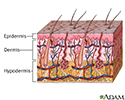Donovanosis (granuloma inguinale)
Granuloma inguinale; Sexually transmitted disease - donovanosis; STD - donovanosis; Sexually transmitted infection - donovanosis; STI - donovanosis
Donovanosis (granuloma inguinale) is a sexually transmitted disease (STD) that is rarely seen in the United States.
Causes
Donovanosis is caused by the bacterium Klebsiella granulomatis. The disease is commonly found in tropical and subtropical areas such as southeast India, Guyana, and New Guinea. There are about 100 cases reported per year in the United States. Most of these cases occur in people who have traveled to or are from places where the disease is common.
The disease spreads mostly through vaginal or anal intercourse. Very rarely, it spreads during oral sex.
Most infections occur in people ages 20 to 40.
Symptoms
Symptoms can occur 1 to 12 weeks after coming in contact with the bacteria.
Symptoms may include:
- Sores in the anal area (in about half of cases)
- Small, beefy-red bumps on the genitals or around the anus
The skin gradually wears away, and the bumps turn into raised, beefy-red, velvety nodules called granulation tissue. They are often painless, but they bleed easily if injured. The disease slowly spreads and destroys genital tissue. Tissue damage may spread to the groin. The genitals and the skin around them lose skin color.
In its early stages, it may be hard to tell the difference between donovanosis and chancroid.
Exams and Tests
Tests may include:
- Culture of tissue sample (hard to do and not routinely available)
- Scrapings or biopsy of lesion
Laboratory tests for diagnosing donovanosis are available only on a research basis.
Treatment
Antibiotics are used to treat donovanosis. These may include:
- Azithromycin
- Doxycycline
- Ciprofloxacin
- Erythromycin
- Trimethoprim-sulfamethoxazole
To cure the condition, long-term treatment is needed. Most treatment courses require 3 weeks or until the sores have completely healed.
A follow-up exam is needed because the disease can reappear after it seems to be cured.
Outlook (Prognosis)
Early treatment helps prevent tissue damage or scarring. Untreated, the disease leads to damage of the genital tissue.
Possible Complications
Health problems that may result from this disease include:
- Genital damage and scarring
- Loss of skin color in the genital area
- Permanent genital swelling due to scarring
When to Contact a Medical Professional
Contact your health care provider for an appointment if:
- You have had sexual contact with a person who is known to have donovanosis
- You develop symptoms of donovanosis
- You develop an ulcer in the genital area
Prevention
Avoiding all sexual activity is the only absolute way to prevent an STD such as donovanosis. However, safer sex behaviors may reduce your risk.
The proper use of condoms, either the male or female type, greatly decreases the risk of catching an STD. You need to wear the condom from the beginning to the end of each sexual activity.
References
Belda W. Granuloma inguinale (Donovanosis). In: Goldman L, Cooney KA, eds. Goldman-Cecil Medicine. 27th ed. Philadelphia, PA: Elsevier; 2024:chap 292.
Eckert LO, Lentz GM. Genital tract infections: vulva, vagina, cervix, toxic shock syndrome, endometritis, and salpingitis. In: Gershenson DM, Lentz GM, Valea FA, Lobo RA, eds. Comprehensive Gynecology. 8th ed. Philadelphia, PA: Elsevier; 2022:chap 23.
Stoner BP, Reno HEL. Klebsiella granulomatis (donovanosis, granuloma inguinale). In: Bennett JE, Dolin R, Blaser MJ, eds. Mandell, Douglas, and Bennett's Principles and Practice of Infectious Diseases. 9th ed. Philadelphia, PA: Elsevier; 2020:chap 235.
Review Date: 8/26/2023









